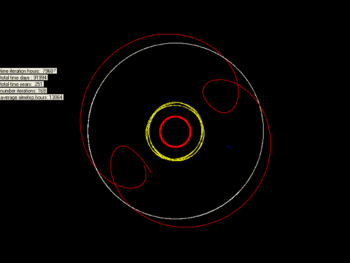55576 Amycus /ˈæmɪkəs/ is a centaur discovered on 8 April 2002 by the NEAT at Palomar.[1]
 Orbital diagram (top view) | |
| Discovery[1] | |
|---|---|
| Discovered by | NEAT |
| Discovery site | Palomar |
| Discovery date | 8 April 2002 |
| Designations | |
| (55576) Amycus | |
| Pronunciation | /ˈæmɪkəs/[2] |
Named after | Amycus |
| 2002 GB10 | |
| Centaur[1][3] | |
| Adjectives | Amycian /əˈmɪsiən/ |
| Symbol | |
| Orbital characteristics[1] | |
| Epoch 13 January 2016 (JD 2457400.5) | |
| Uncertainty parameter 2 | |
| Observation arc | 7204 days (19.72 yr) |
| Aphelion | 35.019 AU (5.2388 Tm) (Q) |
| Perihelion | 15.178 AU (2.2706 Tm) (q) |
| 25.098 AU (3.7546 Tm) (a) | |
| Eccentricity | 0.39526 (e) |
| 125.74 yr (45926.7 d) | |
| 37.041° (M) | |
| 0° 0m 28.219s / day (n) | |
| Inclination | 13.352° (i) |
| 315.45° (Ω) | |
| 239.17° (ω) | |
| Jupiter MOID | 9.92261 AU (1.484401 Tm) |
| TJupiter | 4.133 |
| Physical characteristics | |
| Dimensions | 76.3±12.5 km[4][5] |
| 9.76 h (0.407 d) | |
| ~ 0.18[4] | |
| ~ 20[7] | |
| 7.8[1] | |
The minor planet was named for Amycus, a male centaur in Greek mythology.
It came to perihelion in February 2003.[1] Data from the Spitzer Space Telescope gave a diameter of 76.3±12.5 km.[4][5]
A low probability asteroid occultation of star UCAC2 17967364 with an apparent magnitude of +13.8 was possible on 11 February 2009.[8] Another such event involving a star with an apparent magnitude of +12.9 occurred on 10 April 2014 at about 10:46 Universal Time, visible for observers in the southwest US and western Mexico.[9]
Near 3:4 resonance of Uranus
Amycus (2002 GB10) lies within 0.009 AU of the 3:4 resonance of Uranus and is estimated to have a long orbital half-life of about 11.1 Myr.[10][11]
